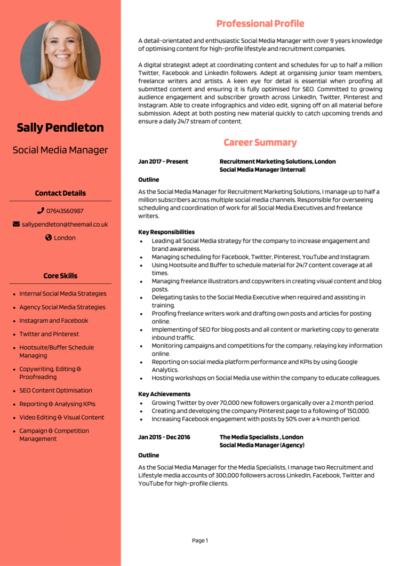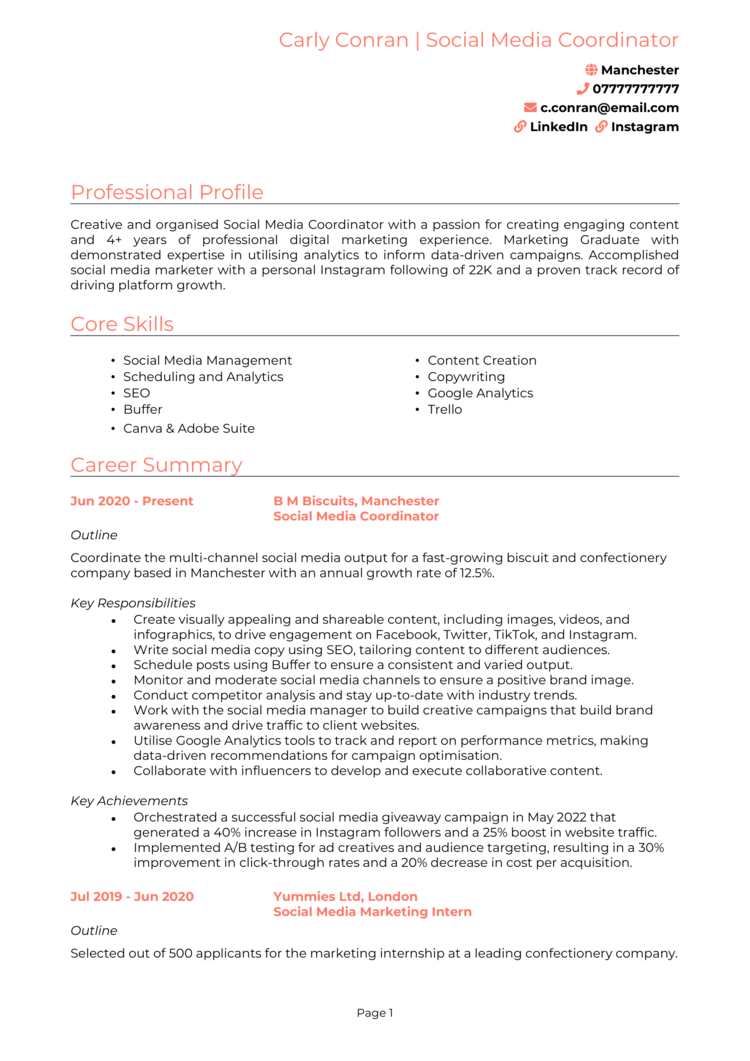Competition in the fast-paced world of social media jobs is unforgiving: you’ll need a CV that proves your knack for creating engaging content and building online communities, if you want to get noticed.
This step-by-step guide, complete with 3 winning Social Media Manager CV examples, will be a great help to produce a good CV which showcases your marketing expertise and analytics know-how to land your next high-paying digital role.
How to write your Social Media Manager CV
Learn how to create your own interview-winning Social Media Manager CV with this simple step-by-step guide.
A Social Media Manager CV is your chance to prove you can create content, build engagement, and interpret metrics to achieve a brand’s goals.
These simple steps will walk you through how to write a CV that highlights your strategic thinking, campaign successes, and adaptability in the fast-paced world of social media.
Social Media Manager CV structure


Think of your CV structure like a well-curated Instagram feed – it needs to be organised and packed with content that makes the recruiter double-tap (or, in this case, shortlist). A clean and professional CV layout ensures that recruiters can find your key skills and accomplishments quickly.
Here’s how to structure your Social Media Manager CV:
- Name and contact details – Put these right at the top so potential employers can connect with you easily. Including a photo is optional but could work well if you’re applying to a creative industry.
- Profile – Craft a concise summary highlighting your campaign experience, creativity, and expertise in analytics.
- Core skills – Show off your abilities, from content creation to paid advertising management.
- Work experience – Detail your career history in reverse chronological order, showcasing the results of your campaigns.
- Education – List your academic qualifications and any digital marketing certifications.
- Additional info – Optionally, include hobbies and interests that reflect creativity or an interest in trends.
Social Media Manager CV format


A CV format with simple, avoidable mistakes is unlikely to make the cut. Even the most qualified candidates will be totally overlooked if the recruiter is struggling to make sense of their impressive content.
Here’s how to format your Social Media Manager CV effectively:
- Bullet points – Use concise, impactful phrases in your CV to highlight your achievements and skills.
- Divide sections – Bold headings and consistent spacing make your CV easy to navigate.
- Use a clean font – Go for a professional font that keeps the focus on your accomplishments, not the design.
- Keep it the right length – Stick to 2 pages. It’s enough length to show off your skills while staying digestible.
Creating your Social Media Manager CV profile


Your professional profile is like the bio on any social media platform – it’s your first chance to make an impression and let the recruiters know who you are and what you bring to the table. You’ll need to convey what benefit hiring you would have for their company.
Social Media Manager CV profile examples
Profile 1
Creative Social Media Manager with five years of experience managing content strategies for e-commerce brands. Skilled in leveraging platforms like Instagram, Facebook, and TikTok to drive engagement and sales. Proficient in using tools such as Hootsuite and Canva to schedule and design high-impact campaigns, achieving a 25 percent increase in follower growth year-on-year.
Profile 2
Organised Social Media Manager with three years of experience working in the hospitality sector, focusing on increasing brand visibility and customer engagement. Skilled in creating visually compelling content, analysing performance metrics, and developing strategies to attract and retain customers. Proficient in Adobe Creative Suite and Google Analytics.
Profile 3
Experienced Social Media Manager with over seven years of expertise in B2B marketing for technology companies. Skilled in creating data-driven campaigns, managing paid ads, and building brand authority on LinkedIn and Twitter. Delivered a 40 percent increase in lead generation through innovative content strategies and audience segmentation.
What to include in your Social Media Manager CV profile
Here are some tips on what to put in your Social Media Manager profile:
- Where you’ve worked – Tell the recruiter which industries or companies you’ve worked for, particularly if they’re relevant to the job you’re applying for.
- Your top qualifications – Note the degrees in marketing or communications, along with certifications like Google Analytics.
- Essential skills – Include campaign planning, community management, and performance analytics.
- Platforms you’ve worked with – Note your expertise in managing platforms like Instagram, TikTok, LinkedIn, or others.
- Content types you’ve created – Specify whether you’ve handled video, blog posts, or interactive content.
Core skills section


Think of the core skills section as your highlight reel. Just like a TikTok montage, it’s your chance to show off your best moves – whether that’s creating viral posts or taming the chaos of multiple social media accounts.
For Social Media Managers, this section should highlight a balance of creative flair and analytical expertise.
Key skills that make a Social Media Manager CV stand out
- Content Strategy – Planning and executing content calendars that align with brand goals and engage audiences.
- Social Media Advertising – Managing paid campaigns across platforms like Facebook, Instagram, and LinkedIn to maximise ROI.
- Community Management – Building relationships with audiences through prompt responses and engaging interactions.
- Analytics and Reporting – Using tools like Google Analytics and Sprout Social to track performance and refine strategies.
- Copywriting – Creating compelling captions, posts, and ads tailored to specific audiences.
- Visual Design – Producing eye-catching graphics and videos using tools like Canva and Adobe Creative Suite.
- Trend Analysis – Staying ahead of the curve by identifying emerging trends and applying them to campaigns.
- Platform Expertise – Proficient in using Instagram, TikTok, Twitter, and other key platforms to drive engagement.
- A/B Testing – Experimenting with content formats and posting times to optimise reach and impact.
- Brand Voice Development – Crafting a consistent tone that aligns with brand identity and audience expectations.
Outlining your work experience


Your work experience section is where you showcase how you’ve turned brands into social media powerhouses. Focus on results-driven campaigns and how your strategies have delivered tangible outcomes.
List your job history in reverse chronological order, with your recent ones at the top. Make sure you provide more detail on the most relevant roles.
If you’re low on professional experience, don’t worry: reference your own social media success and understanding of the algorithm.
How to structure jobs

- Outline – Briefly describe the company, your role, and the scope of your social media responsibilities.
- Responsibilities – Highlight tasks like planning campaigns, creating content, and monitoring analytics.
- Achievements – Include measurable results, such as boosting follower counts, increasing engagement rates, or exceeding campaign KPIs.
Work experience samples for a Social Media Manager
Social Media Manager | GlobalFit Health & Wellness
Outline
Managed social media accounts for a leading fitness and wellness company, focusing on increasing engagement and brand awareness across platforms. Collaborated with the marketing team to align campaigns with overall business goals.
Responsibilities
- Developed and executed content strategies for Instagram, Facebook, and YouTube, achieving consistent follower growth.
- Monitored social media metrics and adjusted strategies to optimise engagement and reach.
- Created visually engaging posts, reels, and stories using Canva and Adobe Creative Suite.
- Planned and managed social media advertising campaigns, ensuring a strong ROI.
- Engaged with followers by responding to comments and messages to build community loyalty.
Achievements
- Increased Instagram followers by 35 percent in one year through targeted campaigns.
- Boosted engagement rates by 20 percent with innovative video content.
- Reduced ad spend by 15 percent while increasing campaign conversions by 25 percent.
Social Media Manager | LuxeStay Hospitality
Outline
Oversaw social media accounts for a luxury hotel chain, focusing on promoting services, engaging with customers, and enhancing brand reputation. Managed campaigns across multiple platforms to attract high-value clients.
Responsibilities
- Created and scheduled content showcasing hotel amenities, special offers, and events.
- Collaborated with photographers and influencers to create high-quality visual content.
- Managed customer interactions across platforms, resolving inquiries and enhancing satisfaction.
- Analysed performance metrics using Google Analytics and adjusted strategies for maximum impact.
- Supported marketing campaigns by developing complementary social media strategies.
Achievements
- Increased direct bookings by 20 percent through promotional campaigns on Instagram.
- Achieved a 30 percent rise in follower count across all platforms in 12 months.
- Recognised by management for improving customer engagement and brand loyalty online.
Social Media Manager | TechSphere Solutions
Outline
Directed the social media strategy for a B2B tech company, focusing on lead generation and brand authority. Collaborated with the content and sales teams to align social campaigns with business objectives.
Responsibilities
- Designed and implemented LinkedIn and Twitter campaigns targeting industry professionals.
- Managed a £100K annual budget for paid social ads, achieving strong ROI.
- Developed engaging thought leadership content, including blog posts and webinars.
- Monitored analytics to track campaign success and refine targeting strategies.
- Liaised with sales teams to generate qualified leads through targeted campaigns.
Achievements
- Increased LinkedIn engagement by 40 percent with thought leadership content.
- Boosted lead generation by 25 percent through targeted ad campaigns.
- Reduced cost-per-lead by 15 percent through effective audience segmentation.
What should your CV’s education section include?


The education section is where you list qualifications relevant to marketing and social media. Include degrees, certifications, or workshops that demonstrate your expertise.
For newcomers to the field, focus on coursework or internships that highlight your potential.
Always list your qualifications in reverse chronological order, starting with the most recent.
Best qualifications for Social Media Managers
- Google Analytics Certification – Demonstrates expertise in tracking and interpreting website and campaign data.
- Meta Certified Media Buying Professional – Validates skills in managing paid advertising on Facebook and Instagram.
- HubSpot Content Marketing Certification – Highlights expertise in creating and distributing content to attract audiences.
- Hootsuite Social Marketing Certification – Covers advanced social media strategies and platform management.
- Bachelor’s Degree in Marketing or Communications – Provides a strong foundation in marketing principles and brand communication.








Social Media Manager CV